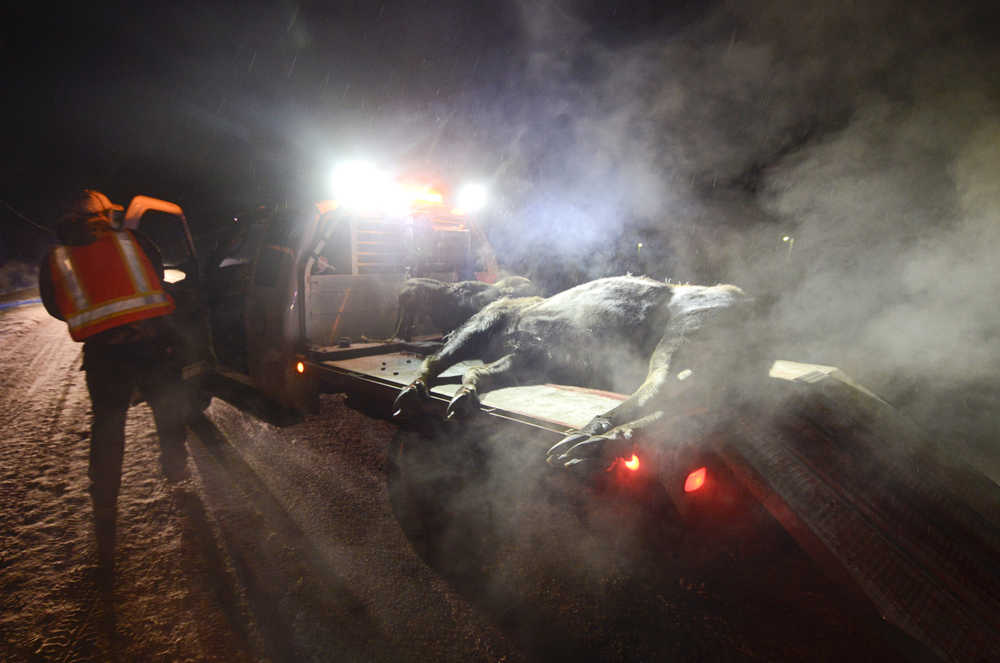Editor’s note: This story has been updated to correct an error. Drivers involved in a moose collision must report it to Alaska State Troopers or, if it occurs within city limits, local law enforcement.
Spotting a moose early, slowing down and passing it safely is the best case scenario for drivers who come across the animals on the Kenai Peninsula’s highways.
All too often, members of the Alaska Moose Federation’s salvage program get a call that sends them racing to the scene of a crash to recover a dead moose.
This year, however, a mild winter helped decrease the number of moose-vehicle collisions on the Kenai Peninsula, said Larry Lewis, a wildlife technician with the Soldotna office of the Alaska Department of Fish and Game.
Together with the federation and with help from the Alaska State Troopers, Lewis keeps a running tally of the moose killed by motorists, and the annual count resets every July 1. This year, the federation counted 167 hit and recovered moose on the Peninsula, compared to 206 in the previous year, said Laurie Speakman, a volunteer truck driver with the salvage program.
“With the snowfall that we didn’t have this year, I think that contributed to lower numbers,” Speakman said. “I think people were more aware this year.”
Speakman and Lewis said mild winters with less snow allow moose to keep to the woods for food and survival. Large amounts of snow force them out of their natural cover and onto the road systems.
“The snow depths certainly have an impact,” Lewis said. “Moose are going to use the path of least resistance. This last winter wasn’t too bad. The living was pretty good off the road system.”
The effect of snow on moose travel patterns generally leads to a slight increase in collisions with them during winter months, Lewis said. Another factor that contributes to heightened chances of a moose collision during winter is the seasonal darkness unique to this part of the country, which lowers driver visibility.
Lewis said peak traffic times, when drivers are commuting to and from work, are the most dangerous times for moose on the highways.
“You’ve got low amounts of ambient light that kind of coincide with driving patterns,” he said.
The effect of oncoming headlights in the dark only makes it harder to spot a moose, Lewis said.
The largest spike in moose-vehicle collisions occurs in the summer. Lewis and Speakman said accidents are more likely to happen both because of increased movement in moose calves and increased summer tourist traffic.
“The spike is usually about the last week of June through July,” Speakman said. “People are getting out and pushing them around a little bit.”
When a moose is hit and killed, it is taken by volunteer salvage drivers like Speakman to one of several local charities, where the meat is donated. However, many moose are not able to be salvaged throughout the year. This year alone, there were 79 moose reported as hit, but never recovered after they made their own way off the highway, Lewis said. During the previous year, 68 moose were hit but not recovered.
The salvage program, which momentarily lost its funding before the Kenaitze Indian Tribe agreed to step in, is not presently up and running. The trucks that volunteers use to recover moose are off the road for repairs and to become “completely safe and road worthy,” Speakman said. After the vehicles are certified with the Alaska Department of Transportation, Speakman said she and the Peninsula’s other volunteers will hit the road again within the next month or so.
Speakman will travel to Anchorage in the coming months to train new salvage program volunteers for the federation. She is also working with local entities to get salvage trucks sponsored.
“I’m always looking for funding,” Speakman said. “I still love what I do.”
Alaska Moose Federation volunteers are not the only people who pay attention to the number of moose hit each year. Spencie Netschert, president of the Alaska Kenai Peninsula chapter of Safari Club International, said the hunting group uses moose fatality numbers to gauge the success of its educational efforts. In addition to advocating for non-subsistence hunters rights, the group engages in some conservation work and sponsors the “Give Moose A Break” signs that can be seen along the Peninsula’s highways.
“We’re trying to get people to slow down a bit,” Netschert said. “So we look at why, why we had such low numbers (of moose-vehicle collisions.)”
The chapter is replacing two weather-beaten signs on Friday, and next year hopes to get another placed along the road on the way to Homer, which currently lacks a sign.
Though the number of moose-vehicle collisions is down slightly this year, the issue is far from being eradicated.
The combined 246 recovered and unrecovered moose hit by vehicles outnumbers the moose killed by hunters on the Peninsula this past year. In 2014, hunters took 207 moose in the game management units covering the Kenai Peninsula, according to Department of Fish and Game data. That means 39 more moose were hit by vehicles than by bullets or bows.
Netschert said a simple tap of the horn will get most moose to move back from the road. Lewis advised that slowing down and driving defensively are the best precautions for drivers to take.
“If you see one moose cross the road, just be really careful because that doesn’t mean there’s not another animal behind it,” Lewis said.
Lewis said drivers often are unaware that it is mandatory to report a moose collision to Alaska State Troopers or, if it occurs within city limits, to local law enforcement.
Reach Megan Pacer at megan.pacer@peninsulaclarion.com


